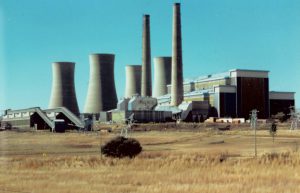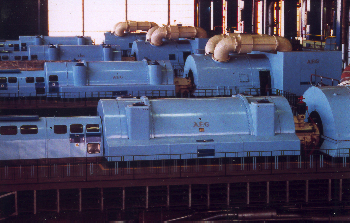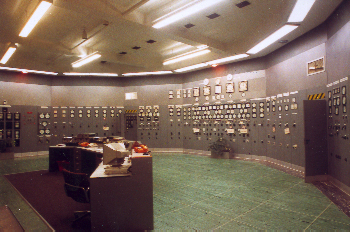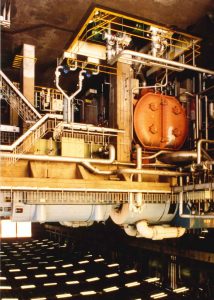Ingagane Power Station

Ingagane power station is located at an altitude of 1197,8m above sea level, 12,8km from Newcastle in Kwazulu-Natal (formerly Natal). It has five 100MW hydrogen cooled turbo-generators, driven by five Pulverised Fuel boilers. During its 27 years of operation, Ingagane fed into an 88 kV network and four 275 kV transmission lines connecting Ingagane with Georgedale, via Bloukrans substation and to Durban and other areas of the province. It was connected to the 400 kV national grid via Chivelston substation. Ingagane’s employees were intensely proud of their 500 MW power station, which boasted an impressive safety record and high staff morale. Indeed, such was the staff devotion to Ingagane that staff turnover was as little as 2%.
Ingagane was ESCOM’s fourthpower station in Natal. By the end of the 1950s, ESCOM had three power stations in operation in Natal, namely Colenso, Congella and Umgeni. Colenso and Congella were already thirty years old and had become less cost-effective. While Umgeni had been providing power since 1954, ESCOM expected demand to exceed output by 1965. As it was, demand for power was doubling every ten years. Consequently, under the chairmanship of Dr. J.T. Hattingh and then his successor Dr. R.L. Straszacker, ESCOM set in motion a £30 million expansion programme in Natal, £25 million of which was to be spent on a fourth power station in Natal. It is quite remarkable to consider that the need for four power stations to supply Natal had been anticipated as early as 1920. After a survey of the province’s electrical needs had been conducted between 1917 and 1920, Mr. John Roberts (Durban’s Electrical Engineer at the time) concluded that there was a need for four large power stations, strategically placed in Natal, which could supply the whole province. This proposal was considered fanciful and Mr. Roberts was accused of being a dreamer. Nevertheless, he was proved correct 43 years later, when Ingagane power station was taken into operation. ESCOM’s fourth power station in Natal was its largest and most economical, at that time.
THE ESTABLISHMENT
Prerequisites for such a power station, which was to have double the output of Umgeni, were abundant cheap coal and water close at hand. This meant that it should not be near Durban, due to the difficulties in the supply of coal. Accordingly, the new power station would have to be located in coal-rich northern Natal. The Dundee, Newcastle or Ballangeich areas were all viewed as possible sites. Negotiations with the Department of Water Affairs led to the proposal that a dam be built on the Ingagane River and the power station be located near the river, south of Newcastle in Northern Natal. This decision also ensured a supply of coal, since Newcastle lies at the northern extremity of the Klip River coalfield.
By 1958, the supply of water and coal had been organised and preliminary work on the site had begun. Water was gravity fed from the Chelmsford Dam via a 16km long pipeline. Coal reached Ingagane from the nearby Kilbarchan colliery via overland coal conveyors, capable of transporting 453,5 tons an hour. Meanwhile following review of the tenders for the first units, the contract was awarded to AEG for the turbo-generators and to I.C.A.L. for boilers 1 and 2.
The removal of generation to the coalfields meant that high-voltage circuits had to be established. Thus it was proposed that Ingagane would feed into the southern networks over a 275 kV transmission line. Much was expected of the new power station. The Natal Undertaking Manager, Mr. H. Alexander felt that it would be a turning point in the cost of electricity. The station’s location in the coalfields meant lower production costs, since the transport of coal would be considerably cheaper.

This was significant, as a number of municipalities and industries in the province were still generating their own power at that time. Cheaper electricity from ESCOM would obviate the need for them to do this.
Construction of Ingagane began in 1959. The next four years saw steady progress being maintained in developing the site. ESCOM also built a village next to the power station with 320 houses for Ingagane’s employees. By 1963, Ingagane power station was ready for commissioning on schedule.
IN OPERATION
The first machine and boiler started work on 29 April 1963 under the direction of Ingagane power station’s first Superintendent, Mr. H.K. (Koop) Groenink. At first, the operation of Ingagane had to be restricted to within the safety limits of its existing transmission equipment. This was due to the fact that the transmission line between Ingagane and the switching and transforming sub-station at Georgedale, which controlled the incoming 275 kV circuits from the power station, was not yet ready. Ingagane’s operational statistics for its first year reveal the following:
| Units generated kWh | Units sent out kWh | Peak kW Max demand | Station load factor % sent out | Coal burned (tons) |
| 276 556 000 | 253 737 700 | —- | 45.7 | 138 658 |
A second turbo-generator was commissioned on 27 February 64 and the second boiler steamed on 6 May 1964.

The power station was designed to operate either as a base load station or a peak load station, with a projected installed capacity of 500 MW. This was much larger than the other three power stations in Natal. Colenso’s was 165 MW, Congella’s 206 MW and Umgeni power station’s 340 MW. Even though it was not yet ready to be exploited in this regard, savings were already being made as a result of the higher efficiency of its 100 MW sets and the saving in railage on coal at this pit-head power station. 1964 costs, Ingagane’s second year of operation, reflected this. The average cost per unit sold, decreased by 2,4%.
Meanwhile, output from Natal’s power stations combined, expanded to 3012 million units, an increase of 14,6% over the 1963 figure and maximum demand rose from 465 660 kW to 515 600 kW. Sales grew to 2,922 million units, an increase of 14.9%. These main increases came about due to a greater demand from the Durban Corporation, the Pietermaritzburg Corporation, South African Railways and Feralloys Ltd works at Cato Ridge.
1967 to 1968 saw another three 100 MW units being added, thereby attaining Ingagane’s final design capacity. Boilers 3, 4 and 5 had been manufactured by Mitchell Engineering, AEG again supplying the turbo-generators. The four 93,4 m high cooling towers and two 119,48 m high stacks had also been completed. The outlet gases from Boilers 1 and 2 passed through electrostatic precipitators before entering Stack 1. Boilers 3, 4 and 5’s dust-laden gases also passed through electrostatic precipitators on their way to Stack 2. It is interesting that Boiler 3 made use of a ball mill controlled by acoustics that pushed its output to 105 MW, while the others had roller mills. In addition, Ingagane’s layout permitted cross steaming, a feature which was later eliminated during refurbishment. At this time, the power station was generating approximately half of the units generated by the Natal undertaking.
By the end of 1968, Ingagane’s boilers had steamed as follows:
| BOILER | HOURS STEAMED: |
| 1 | 40 085 |
| 2 | 35 959 |
| 3 | 14 319 |
| 4 | 6062 |
| 5 | 1660 |
| TOTAL | 98085 (4087 days |

Control Room
Prior to this Mr. Groenink had left. He was succeeded by Mr. R.B. Cliff, who left in 1968 to be replaced by Mr. Gordon Ritchie.
As noted above, coal was supplied by Kilbarchan Colliery. While the supply was satisfactory (it had to be, considering Ingagane consumed some 1,7 million tons of coal annually), the moisture content was not. In the 1970s, the operators used to joke that it would have been easier to burn ‘painted rock’. At times, they had to ignite the boilers’ oil-burners to keep the flame steady.
In 1987, underground water at Kilbarchan increased the coal’s superficial moisture content, causing coal hang-ups and feeder blockages at Ingagane. Fortunately, the power station was designed to operate with poor quality coal. By 1969 it had burnt more than 5 million tons of it.
The resultant ash was drawn from the boiler hoppers by means of water jets and conveyed by pipeline to the ash dumps at the nearby disposal site. The ash dams were carefully monitored and managed, although in February 1970, about 100,000 tons of ash was scoured from the main ash dam when a 610m section of it collapsed. The authorities had to move quickly to prevent pollution of the Ingagane River. This event prompted the writing of a poem by C. M. Marshall, one of Ingagane’s employees. (See Appendix B).
During the winter of 1971, all of Natal’s power stations operated at maximum capacity to meet the load without major assistance from the Transvaal power stations. The year did however begin with a major power failure in Natal. A fault near the Georgedale station caused both transmission lines from Ingagane to trip. The power station had to be isolated from the system and the load switched to Congella, Umgeni and Colenso. A concern at Ingagane was how the power station would restart itself if there was a total blackout and it was completely ‘islanded’. There was no generator big enough to do this at Ingagane. A successful experiment conducted in the 1980s, involved the newly built Drakensberg Pumped Storage Station restarting Ingagane.
In 1972, the interconnection of Natal’s four power stations with the large pithead power stations in the Transvaal was enhanced with the completion of the second 400 kV line from Camden and Chivelston. This allowed the older and less efficient Congella and Colenso to reduce output. Accordingly Ingagane became more important for the Natal Undertaking. During this decade, the generation of electricity in South Africa increased by about 8% a year and by 1981 the country was using about 100 000 GWh a year, compared to approximately 22 500 GWh twenty years before. During the same period, per capita consumption of electricity trebled, from 1125 kWh to 3500 kWh.
Ingagane contributed to this growth. Its 1973 statistics indicated the following:
| Units generated GWh | Units sent out GWh | Maximum demands 1 hour sent out kW | Overall thermal efficiency % | Availability | Total water consumed (litres USO) | Coal burnt (metric ton) |
| 3161,1 | 2967,0 | 492 000 | 31,7 | 89,7 | 3,60 | 1 451 596 |
Ingagane provided 80% of the total units sent out by Natal’s four power stations. This amount had increased by 30% since 1968. Umgeni generated 10% of the total, while Congella and Colenso contributed about 5% each.
At this time, Mr. Ross Hatton was the power station Superintendent, Mr. Ritchie having been transferred in 1971. In 1976 Mr. Dries Struwig succeeded Mr. Hatton. Mr. Struwig remained there until 1981. One anecdote of interest from this period concerned Ingagane’s operators’ ability to tell the time on a Tuesday evening without the need for a clock. The hugely popular television programme Dallas was responsible for this. There was always a big demand for power ten minutes before the programme (as people made tea and so on) and immediately after the programme. Operators knew when the programme began or ended simply by the demand for power.
Ingagane’s employees speak highly of its working conditions and its reliability. Ingagane had a good reputation and attracted top-class artisans. Safety was always a major concern with ESCOM and the power station’s lockout systems were of the highest order. Indeed, it broke a number of safety records, having almost ten million operational hours accident free. This won Ingagane power station the prestigious Terry Trophy for safety in South Africa. Other awards included the Excellence in Occupational Hygiene Award in September 1988. When the 1985 drought in South Africa caused the water level in the Chelmsford Dam to drop below that of the outlet pipe to Ingagane, with the result that it was shut down for eight months, the staff used this opportunity to maintain and clean the station.

THE INGAGANE COMMUNITY
While the completion of Ingagane in 1968 had meant that the power station could contribute to a much greater extent to power supply in Natal, the departure of the construction firms had a negative impact on the Ingagane power station’s Staff Club revenue. These firms’ employees had boosted the canteen’s profits considerably and the loss was keenly felt. Clubs such as these were prominent at Ingagane. Unlike power stations such as Umgeni and Congella located in Durban, Ingagane’s position meant it was more isolated. Those living in the ESCOM village at the power station had to provide their own entertainment and recreation. The employees of the power station and their families formed a small fraternal community of people, with often both husband and wife working at the power station.
The first bowling green was opened on 30 January 1964 and from there a full range of sporting activities developed. These included cricket, rugby, shooting, tennis, swimming, badminton (which achieved considerable success) and snooker. Facilities were provided for all of these sports. An extract from Ingagane sports club’s 1968 report testifies to the community’s enthusiasm for sport. The annual general meeting of the sports club was held recently, and it was gratifying to note that 100 members were sufficiently interested in the proceedings to attend. ESCOM nominated members to the Managing Committee for the year were as follows:-
President: Mr. H. P. Alexander
Vice-President: Mr. H. K. Groenink
Chairman: Mr. G. H. Ritchie
Vice-Chairman: Mr. B. Westwood
Committee members for 1969 are as follows:-
J.G. Arkeoll, J. D. Aspden, C. A. H. Brown, R. H. Carr, C. J. Cloete, D. V. Ellis, A. Grant, E.G. F. Koho, E.C. Labuschagne, C. A. Law, K. S. Marshall, R. G. Marshall, P. J. Mostert, S. R. Reynolds, A. Strong, P.H. Viljoen.
The President of the Club, Mr. H. P. Alexander, and Mrs. Alexander, as well as the Vice-President, Mr. H. K. Groenink, and Mrs. Groenink, were all present at the meeting, having travelled from Durban to attend…Mrs. Jean Cliff presented the various section prizes after the meeting, after which tea was served, bringing to a conclusion another Club year.
Relations with Newcastle also mainly concerned sport. Newcastle residents did tend to think that the power station supplied the town’s electricity and when there was a power failure, they would phone the Superintendent and complain. Nevertheless relation were amiable. There were also sporting links with Congella, Colenso and Umgeni power stations, as well as the other collieries and companies in the Newcastle area. Ingagane employees also competed in first aid and firefighting competitions on a regional and national basis. Sr. Cockburn, the Industrial Nurse at Ingagane, started the first St. John’s Ambulance and Nursing Division on a power station by training seven ladies as home nurses. The Ingagane community also had a drama section and a pop group. Then there were the various personalities. One was Sid Reynolds, who flew a radio-controlled plane around the power station and compèred the drama section’s shows. Another was Peggy Marshall, Ingagane’s poetess. Her poems appeared in Megawatt, the quarterly staff magazine then published by ESCOM (see Appendix C for an example of these).
DECOMMISSIONING
A decrease in the demand for electricity during the 1980s and early 1990s and the commissioning of new larger power stations resulted in excess generating capacity. Consequently, the older power stations were no longer required and Eskom decided to store certain of them. Eleven stations altogether were going to be put into storage or mothballed. Eskom decided that Ingagane power station would be mothballed in 1990 and brought back into service in 1996, when it was anticipated that it would be economically viable to do so. The power station was estimated to have a service life of a further 20 years with proper maintenance.
By 1987, annual operating costs for Ingagane were as follows:
| Coal | R 27 306 000 |
| Fuel Oil | R 13 810 000 |
| Manpower | R 12 184 000 |
| Material | R 1 257 000 |
| Contracts | R 2 278 000 |
| Total | R 56 835 000 |
The mothballing process began that year. At 5:00am, on 8 January, the first unit was shut down. The remaining units followed between September 1988 and November 1990. On 5 November 1990, at a small ceremony, Mr. Chris Steyn (Mr. Struwig’s successor) shut Unit no. 5 down. Ingagane’s boilers had steamed more than 760 000 hours by November 1990 and sent out on average 1 314 957 GWh per annum at a unit cost of 6c/U.S.O. By this stage most of the approximately 680 staff had left, some having been redeployed to other power stations, others having taking early retirement. Ingagane was mothballed under strictly controlled conditions, which included a system based on VGB guidelines and the circulation of dehumidified air through the steam and condensate systems. The ash disposal site was also rehabilitated.
Thus, Ingagane Power station awaited recommissioning. However, this was not to be. In 1994, it was no longer deemed necessary or viable for Eskom’s Integrated Electricity Plan. Recommissioning would have been too costly and the decision was taken to dispose of it. In an attempt to encourage competition in the local power production industry, the years 1995 to 1998 saw Eskom offering Ingagane power station for sale and in response, several European companies showed interest in purchasing it. This prospect did not materialise, with the result that it seems likely that Ingagane is going to be sold for scrap. At the moment, removal of the asbestos lagging to the boilers and steam pipes is being carried out, a task that should be completed towards the end of 2000. For the time being, this ‘cute little power station’ remains where is has stood for 37 years, it machinery and buildings intact. It is a testimony to the technology and economic development of another era in South Africa.
INGAGANE POWER STATION’S SUPERINTENDENTS/MANAGERS
Mr. H.K. (Koop) Groenink had been the superintendent of Colenso power station and left Ingagane in 1966 to take up the position of Area Generation Engineer.
Mr. R.B. Cliff was Ingagane’s manager between 1966 and1968. He was then transferred to Grootvlei.
Mr. Gordon Ritchie came from the Vaal Power station. In 1971, he was transferred to Northern Pooled Stations.
Mr. Ross Hatton was Superintendent between 1971 and 1976. He was also Mayor of Colenso.
Mr. Dries Struwig succeeded Mr. Hatton in 1976. He remained in the position until 1981.
Mr. Chris Steyn occupied the position until 1994.
A sequel to THE ODE TO AN ASH DAM
By C. M. Marshall
We’re back to the Ash Dam again,
It is becoming a constant refrain,
It seems hard to believe,
But the ghosts just won’t leave
The site which once held their remains.
As the credulous readily agree
The burst in the Ash Dam must be
The result of disturbance
And subsequent perturbance
Of ghosts who object to ESC.
Now don’t take me amiss, I implore
I am just repeating the lore
Which comes from the few
Who are taking their cue
From the ash which flows out from the flaw.
For we, who are somewhat enlightened,
Are keen to reassure all the frightened,
That soon all will be clear
And the dam we hold dear
Will be mended, with all corners tightened.
In the meantime our V.I.P.s converge
On our station, and stand round the verge
Of the dam site – so broken -That all hushed words spoken
Sound eerie – and just like a dirge.
It’s a sad moment, when one counts the waste,
All the fish – and the labour – erased.
But we’ll rally our forces
And use all our resources
To regain a splendour that’s chaste.
And soon from the rubble, the old Dam will soar,
It’s grace quite unbroken by gashes or flaw,
All peace will abide
O’er the whole countryside,
And the spirits will rest evermore.
INGAGANE’S BABIES
By Peggy Marshall
All life has to offer you,
And all life’s joys
Can be said to start with
Baby girls and boys.
They bring happiness to many
With perhaps a grief or two!
But on the whole they make the world
A nicer place for you.
At Ingagane especially, one
Finds a bumper crop,
Of tiny darling babies, not
One of whom’s de trop.
BIBLIOGRAPHY
This information on Ingagane power station was produced by Stephen Leech, Associate Lecturer, the Department of History, University of Durban-Westville.
Publications:
Department of Foreign Affairs and Information Republic of South Africa: 20 years of progress (Tri-Rand/Litho Co, Pretoria, 1981).
Duminy, A and Guest, B (eds.), Natal and Zululand: From Earliest Times to 1910 (Pietermaritzburg, University of Natal Press, 1989).
Durban Electricity Department Electricity Distribution in the Durban Region: The First Seventy-Five Years 1897-1972 (Durban, Time Printers, 1972).
Electricity Supply Commission’s Annual Reports
Megawatt
Natal Undertaking Manager’s Annual Report
Newspapers:
Daily News
Natal Mercury
Sunday Times
Sunday Tribune
Interviews:
Interview with Mr. Mike Manden, 23 November 1999.
Interview with Mr. Rick Hodge, 25 November 1999.
Interview with Mr. Chris Steyn, 25 November 1999.
Other:
Information from Mr. Chris Steyn’s personal files.
